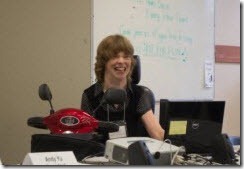Synthesized Voices: Not Unique Sounding, Until Now

Imagine hearing a voice before seeing the individual.
Chances are you can ascertain much information about the person from the voice which is as unique as a fingerprint: the person’s rough age, usually the gender and ethnicity, as well as the individual’s emotional state and more.
Individuals can be recognized by the sound of their voice.
However, for the the hundreds of thousands of individuals with speech impairments who rely on devices to communicate, this unique sound does not exist. Rather, they rely on a limited number of synthesized voices to be their voice.
The synthesized voice used by a world-renowned astrophysicist might be the exact same voice used by a 6-year-old boy entering elementary school or, sadly, even by a 6-year-old girl. These robot-sounding voices lack uniqueness, individuality and personality.
Individuals with speech impairments who rely on communication devices cannot be recognized by the sound of their voice.
Canadian speech scientist Rupal Patel took issue with this lack of unique-sounding voices in this often-ignored segmented of the population and did something about it!
Patel, an associate professor of speech language pathology and audiology at Northeastern University in Boston, “has developed technology and algorithms that mix the voice of a speech-impaired person with that of a healthy "speech donor.†(from CBC Technology & News)
Very briefly, she takes the voice (which might be as little as a few sounds) from an individual with impaired speech (the recipient) and mixes it with the sounds of a voice donor to create a customized, synthetic voice. Her 6-year-old daughter describes it as “mixing colours to paint voices.†Only the recipient receives this voice; no one else will ever have the same synthesized voice.
Watch her TED talk where Rupal’s explains her exciting project:
(Unfortunately this video is not captioned. For more information in text format, read Everything you need to know about donating your voice: Why you should help The Human Voicebank Initiative.)
For someone who relies on a synthesized voice – the same one as heard over the PA system at the Honolulu airport – when I deliver presentations, using my own, unique voice would be beyond unbelievable! Actually, merely thinking about it brings tears to my eyes.
For more information about the project and to become a voice donor or a voice recipient, visit the website VocalIiD.org. If you have been blessed to have an understandable voice, I’d like to challenge you to become a voice donor and potentially change someone’s life.
For more of information about how I deliver motivational presentations with a synthesized voice, please visit my speaker site.
If you enjoyed this post, consider buying me a chai tea latte. Thanks kindly.
 Subscribe via RSS
Subscribe via RSS



